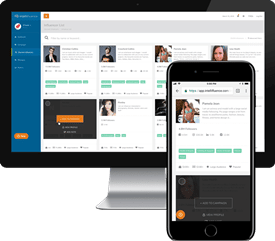Last Updated on June 8, 2020
Influencer marketing is an increasingly popular trend for B2C and B2B businesses across the web. It typically falls under social marketing and gives brands an alternative to paid promotions outside of sponsored content. Many marketers appreciate the opportunity to connect with new audiences and sell their items to people who are just learning about their brands.
While influencer marketing is popular, it must be done correctly to work well. Follow these five steps to get your influencer marketing campaign off the ground.
1. Set Goals and Target Metrics for Your Influencer Campaign
Before you can choose a platform, create a campaign, or even contact your first influencers, you have to set goals for your business and influencer marketing strategy. Ask yourself a few questions as you set metrics for success of your brand:
- Where in the sales funnel will your influencer audiences fall?
- What will you consider a successful conversion for your brand?
- If you are driving audiences to your website, what pages will they visit?
These questions will guide your target KPIs and help you decide what realistic results would look like for your brand. Some companies are convinced that influencer marketing should drive immediate sales, even though the promotion targets customers at the very top of the sales funnel.
It’s okay if your first influencer efforts are meant to create a base for future growth. However, you should at least set some basic ROI and traffic goals to make sure your budget doesn’t go to waste the first time you work with influencers.
2. Choose Which Platforms You’ll Use for Influencer Promotion
Before you can choose your influencers, you need to decide which channels will help you reach your goals. Instagram might work for some brands (particularly in the fitness, fashion, and food industries) but might not be right for yours. Consider the target demographics of various social media channels to filter through influencers that will effectively reach the audiences you are targeting.
Along with social media channels, you can also target influencers who post content on their own blogs and websites. Choosing these platforms can help drive links back to your pages and provide in-depth reviews and analyses of your products.
According to MarketingProfs, 99 percent of all B2C influencers operate on Instagram and 70 percent of these influencers have a strong presence on Facebook. These numbers could skew significantly in the B2B space, where Twitter and LinkedIn have more heft.
3. Find Influencers Who Fit Your Brand Size and Industry
The influencers you choose will have a significant impact on your influencer marketing strategy. You want to select influencers who have a large following, but who aren’t too large. If you work with influencers who are too big for your company, then you could blow through your budget faster than you planned or fail to see results.
Targeting only large influencers can put off medium-size influencers who could be just as effective as large ones — if not more so. You might reach more people with large influencers, but convert more with smaller ones.
Intellifluence creates brackets so you can limit your audience size. You can target micro-influencers (up to 5,000 followers), medium influencers (5,000 – 50,000 followers), or large influencers (more than 50,000 followers). Once you have an influencer size goal, you can move forward with your campaign.
4. Develop a Message That Connects With Users
Once you finish with the technical aspects of your influencer marketing campaign, you can start to focus on the creative strategy. Your influencers might request written copy for promotions, need details on specific products, or even need samples to create content that aligns with their brand. A large part of influencer relationship building comes during the creative process, as you get to know what makes their marketing successful and they get to know your brand.
Influencer marketing isn’t a one-size-fits-all process. Your influencers will tailor your message to their audiences, and you will need to work with them to make sure the content stays on-brand without alienating their followers.
Many brands create style guides for their influencers to follow. These guides show influencers what they can do and what they can’t. For example, you can specify restrictions related to your logo or limit adult content or profanity in the promoted posts.
5. Check to See What Works and What Doesn’t
Your social marketing campaigns don’t end when your influencers publish and your customers visit your website. In fact, that is just the beginning of the process. As you start to get your first results back from your influencer marketing campaigns, check to see what worked and what didn’t. Create a list of action items to improve your influencer targeting, campaign content, and overall promotional size. Now that you have your base metrics, it’s time to grow!
Regardless of your brand size, goals, and industry, influencer marketing needs to be part of your brand strategy. Use this guide’s tools to kick off your social marketing strategy with Intellifluence.

SallyBot is committed to helping users get the most out of Intellifluence. By helping brands create campaigns, providing unparalleled customer service and offering useful advice, nothing makes SallyBot happier than hearing she is liked… Really, really liked.






